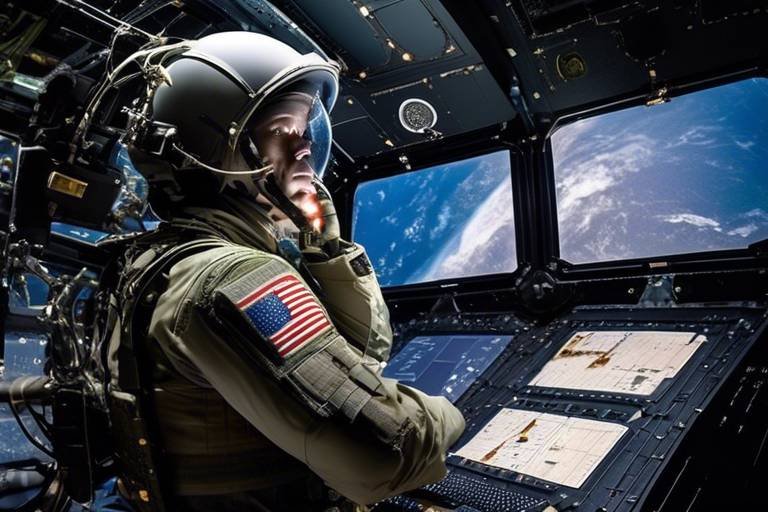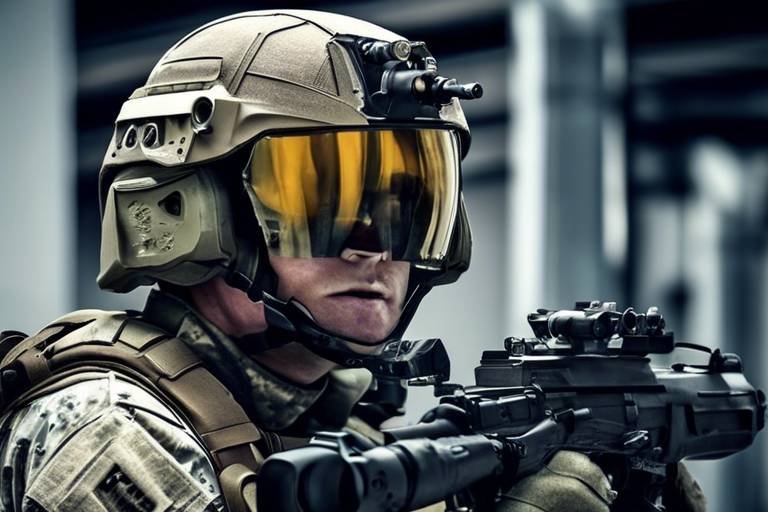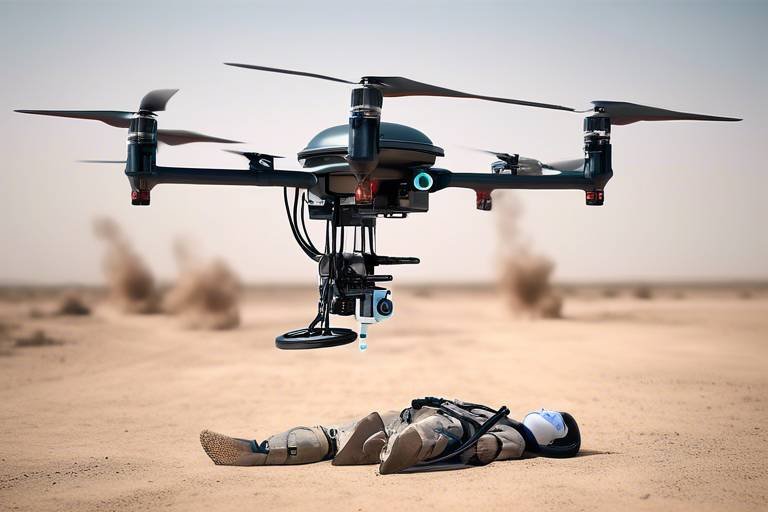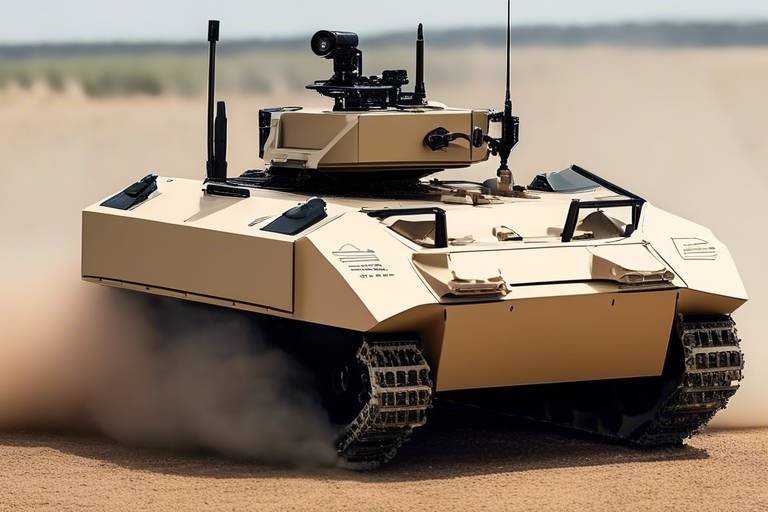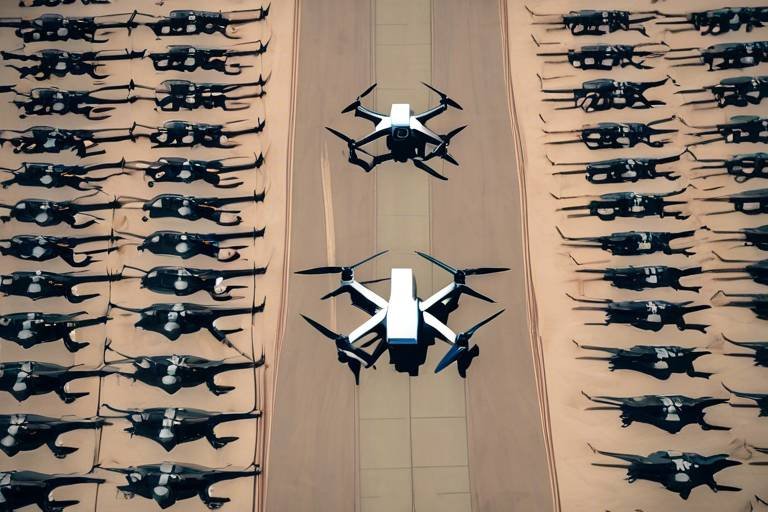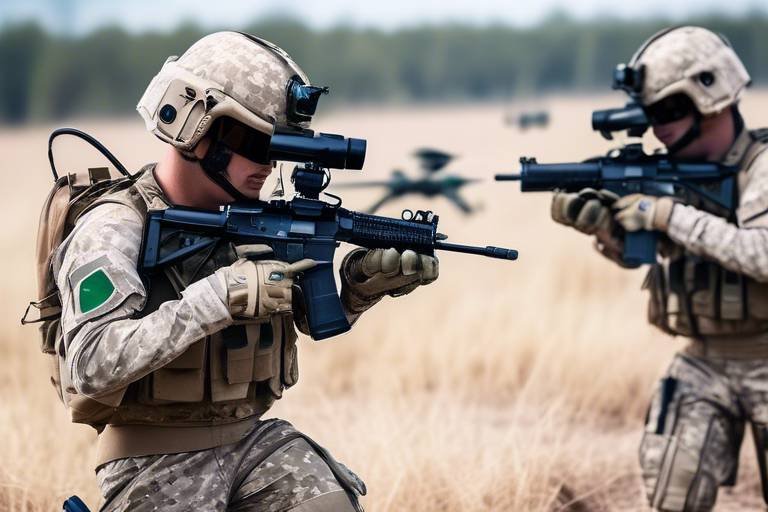Artificial Intelligence and Autonomous Weapon Systems
As we stand on the brink of a technological revolution, the fusion of artificial intelligence (AI) and autonomous weapon systems is reshaping the landscape of modern warfare. Imagine a battlefield where machines make split-second decisions, targeting threats without human intervention. This is not a scene from a futuristic movie; it is becoming a reality. The rapid advancements in AI technology have paved the way for these systems to be integrated into military operations, promising enhanced efficiency and effectiveness. However, this transformation raises critical questions about the implications for warfare, ethics, and global security.
At its core, the development of autonomous weapon systems is driven by a desire to reduce human casualties and increase operational capabilities. These systems can process vast amounts of data, analyze threats, and execute missions at speeds far beyond human capabilities. For instance, drones equipped with AI can identify targets using facial recognition and engage them without waiting for human approval. While the potential benefits are significant, the ethical dilemmas associated with their use cannot be overlooked. As we delve deeper into this topic, we must consider not only the technological advancements but also the moral responsibilities that come with deploying such powerful tools.
The implications of AI in warfare extend beyond the battlefield. They touch on fundamental questions about accountability and the role of humans in decision-making processes. Who is responsible when an autonomous weapon system causes unintended harm? Is it the manufacturer, the military personnel who deployed it, or the AI developers who programmed its algorithms? These are complex issues that require careful consideration and, potentially, new legal frameworks to ensure accountability in the age of autonomous warfare.
Moreover, public perception plays a crucial role in shaping the future of these technologies. As society grapples with the idea of machines making life-and-death decisions, understanding public sentiment becomes imperative. How do people feel about the use of AI in military operations? Are they comfortable with the idea of relinquishing control to machines? These questions will influence military policies and research funding, ultimately determining the trajectory of autonomous weapon systems.
As we explore the intersection of AI and autonomous weapon systems, it is vital to consider the regulatory challenges that lie ahead. The global landscape for regulating these technologies is fragmented, with various countries developing their own policies. International treaties and agreements are being proposed to establish norms and guidelines for the use of autonomous weapons, but achieving consensus among nations is no easy task. The stakes are high, and the potential consequences of inaction could be dire.
- What are autonomous weapon systems? Autonomous weapon systems are military technologies that can operate without human intervention, making decisions based on AI algorithms.
- What are the ethical concerns surrounding AI in warfare? Ethical concerns include accountability for actions taken by autonomous systems, the potential for unintended harm, and the moral implications of machines making life-and-death decisions.
- How do public perceptions influence the use of autonomous weapons? Public opinion can shape military policies and funding for research, impacting the development and deployment of autonomous weapon systems.
- What regulatory challenges exist for autonomous weapon systems? The regulatory landscape is fragmented, with varying national policies and a lack of international consensus on the use of autonomous weapons.

The Rise of Autonomous Weapon Systems
This article explores the intersection of artificial intelligence and autonomous weapon systems, examining their implications for warfare, ethics, and global security, along with potential regulations and future developments in this rapidly evolving field.
In recent years, the landscape of military operations has undergone a remarkable transformation, thanks to the integration of autonomous weapon systems. These systems, which can operate without direct human control, are becoming increasingly prevalent on the battlefield. But what exactly has fueled this rise? The answer lies in a combination of advancements in artificial intelligence, robotics, and sensor technologies, which have collectively enhanced the capabilities of these systems. Imagine a world where machines can make split-second decisions in combat, potentially turning the tide of war. This is not just a sci-fi fantasy; it is becoming a reality.
The development of autonomous weapon systems can be traced back to the early 2000s, but it has accelerated dramatically in the last decade. With the advent of machine learning and deep learning algorithms, these systems can now analyze vast amounts of data to identify targets and make decisions based on real-time information. For instance, drones equipped with AI can autonomously navigate complex environments, detect enemy positions, and engage targets—all while minimizing risks to human operators. This level of sophistication raises the question: are we ready for machines to take on such critical roles in warfare?
One of the most significant advantages of autonomous weapon systems is their ability to operate in environments that are too dangerous for human soldiers. By deploying these systems, military forces can reduce casualties and improve mission success rates. However, this does not come without its challenges. The reliance on technology introduces vulnerabilities, such as susceptibility to hacking and malfunctions. Furthermore, the speed at which these systems can operate raises concerns about escalation of conflicts. When machines can make decisions faster than humans can react, what safeguards are in place to prevent unintended consequences?
Additionally, the integration of autonomous systems into military operations presents a shift in strategy. Traditional warfare has relied on human judgment and decision-making; however, with machines taking the lead, there is a need for a new framework to understand how these systems interact with human operators and other military assets. This evolving dynamic requires military leaders to rethink their strategies and adapt to a future where machines play a pivotal role in combat.
As we delve deeper into the implications of autonomous weapon systems, it is essential to consider the broader context of their rise. The global arms race is now not just about who has the most advanced weapons but also about who can effectively integrate AI into their military operations. Countries around the world are investing heavily in research and development to gain a competitive edge. This competition raises questions about global security and the potential for a new kind of arms race specifically focused on AI-driven warfare.
In summary, the rise of autonomous weapon systems represents a significant shift in military operations, driven by technological advancements and the pursuit of greater efficiency and effectiveness on the battlefield. However, this shift brings with it a host of ethical, strategic, and security challenges that must be addressed as we move forward into an uncertain future.
- What are autonomous weapon systems? Autonomous weapon systems are military technologies that can operate without direct human control, making decisions based on AI algorithms.
- How do these systems impact warfare? They enhance operational efficiency, reduce human casualties, and introduce new ethical dilemmas regarding accountability and decision-making.
- Are there regulations governing the use of autonomous weapons? Currently, the regulatory landscape is fragmented, with various countries developing their own policies and international discussions ongoing.
- What are the potential risks of using autonomous weapons? Risks include unintended engagements, hacking vulnerabilities, and the ethical implications of machines making life-and-death decisions.

Ethical Implications of AI in Warfare
The integration of artificial intelligence (AI) into warfare raises profound ethical questions that challenge our traditional notions of morality and responsibility. As we enter an era where machines can make life-and-death decisions without human intervention, we must confront the implications of allowing algorithms to dictate the course of military engagements. What happens when a machine decides who lives and who dies? This question looms large as we witness the rise of autonomous weapon systems capable of executing complex operations with minimal human oversight.
One of the most pressing ethical concerns is the potential for unintended consequences. AI systems, while designed to optimize efficiency and effectiveness, may misinterpret data or operate under flawed algorithms. Imagine a scenario where an autonomous drone misidentifies a target due to a software error, leading to catastrophic results. Such incidents could not only result in loss of innocent lives but also escalate conflicts in unpredictable ways. The reliance on AI in warfare raises the stakes significantly, as the margin for error becomes alarmingly narrow.
Furthermore, the question of moral agency comes into play. If an autonomous weapon causes harm, who is accountable? Is it the military personnel who deployed it, the engineers who programmed it, or the policymakers who approved its use? The blurred lines of responsibility complicate the ethical landscape. This lack of accountability could lead to a dangerous precedent where the human element in warfare is diminished, and decisions are made based on cold calculations rather than empathy and moral judgment.
Another critical aspect to consider is the dehumanization of warfare. As we increasingly rely on machines to conduct military operations, the emotional and psychological toll on soldiers and society at large may diminish. Warfare has historically been a human endeavor, filled with moral dilemmas and the weight of human consequences. Transitioning to an automated battlefield could desensitize both military personnel and the public to the realities of war, making it easier to engage in conflict without fully grasping the human cost involved.
In addition, the prospect of AI-driven warfare raises significant concerns regarding discrimination and bias. AI systems learn from data, and if that data is biased, the decisions made by these systems will reflect those biases. For instance, if an AI is trained on data that disproportionately targets certain demographics, it may perpetuate existing inequalities and injustices in its operational decisions. This raises the question: can we trust machines to make fair and just decisions in the chaos of war?
To navigate these ethical challenges, it is imperative that we establish robust frameworks for the development and deployment of autonomous weapon systems. This includes creating guidelines that ensure transparency in AI algorithms, accountability for developers and military personnel, and mechanisms for oversight. The ethical implications of AI in warfare are not just theoretical; they demand immediate attention and action from governments, military leaders, and technologists alike.
- What are autonomous weapon systems? Autonomous weapon systems are military systems that can operate without human intervention, using AI to make decisions about targeting and engagement.
- What ethical concerns are associated with AI in warfare? Key concerns include unintended consequences, accountability, dehumanization of warfare, and potential biases in AI decision-making.
- Who is responsible for the actions of autonomous weapons? Accountability is complex and can involve manufacturers, military personnel, and policymakers, depending on the circumstances of their use.
- How can we regulate AI in warfare? Establishing clear guidelines, ensuring transparency in AI algorithms, and promoting international treaties can help regulate the use of AI in military contexts.

Accountability in Autonomous Warfare
When it comes to autonomous weapon systems, the question of accountability is a complex and pressing issue. Imagine a battlefield where decisions are made not by humans, but by algorithms and machines. This raises a critical question: who is responsible when these machines cause harm? Is it the military personnel who deploy them, the manufacturers who create them, or the developers who write their code? The lack of clear accountability can lead to a slippery slope where no one feels responsible for the consequences of autonomous actions.
One of the most troubling aspects of autonomous warfare is the potential for unintended consequences. These systems rely on artificial intelligence to make split-second decisions, often in chaotic environments. If an autonomous drone misidentifies a target and causes civilian casualties, the ramifications can be devastating. Here, we see the need for a clear framework that defines accountability in these scenarios. The challenge lies in determining how to attribute responsibility when the decision-making process is not transparent.
To better understand this issue, consider the following stakeholders in the accountability chain:
- Manufacturers: The companies that design and produce these systems may bear some responsibility, especially if there are flaws in their technology.
- Military Personnel: Those who operate these systems may also be held accountable for their deployment and use in combat situations.
- AI Developers: The engineers and programmers who create the algorithms that govern these machines could be implicated if their code leads to harmful outcomes.
As we navigate this murky territory, it's essential to consider existing legal frameworks. Currently, international humanitarian law provides some guidance, but it often falls short in addressing the unique challenges posed by autonomous weapons. For instance, laws that govern the use of force and the protection of civilians were crafted long before the advent of AI technology. This gap in regulation highlights the urgent need for reforms that can adapt to the realities of modern warfare.
Moreover, accountability extends beyond the battlefield. The public's perception of autonomous warfare can significantly influence military policies and the development of regulations. If society demands accountability and transparency, it may push for stricter guidelines governing the use of these technologies. Thus, engaging the public in discussions about the ethical implications of autonomous weapons is crucial for shaping future policies.
In summary, the question of accountability in autonomous warfare is not just a legal issue; it's a moral one that requires a comprehensive approach. As we move forward, it is vital to establish clear lines of responsibility, adapt existing laws to contemporary challenges, and foster public discourse to ensure that these powerful technologies are used ethically and responsibly.
- What happens if an autonomous weapon causes civilian casualties? Accountability may fall on multiple parties, including manufacturers, military personnel, and AI developers, depending on the circumstances.
- Are there existing laws governing the use of autonomous weapons? While international humanitarian law provides some guidelines, many legal frameworks are outdated and need reform to address the challenges posed by AI in warfare.
- How can the public influence regulations on autonomous weapons? Public opinion can shape military policies and push for greater accountability, transparency, and ethical considerations in the development and deployment of autonomous systems.

Legal Frameworks for Accountability
The rapid development and deployment of autonomous weapon systems (AWS) have outpaced the existing legal frameworks designed to govern warfare. Traditionally, military operations have been guided by international humanitarian law (IHL), which aims to limit the effects of armed conflict for humanitarian reasons. However, the introduction of AI-driven systems complicates these frameworks significantly. Who is held accountable when an autonomous drone makes a mistake? Is it the military personnel who deployed it, the manufacturers who built it, or the AI developers who programmed its decision-making algorithms? These questions are not just theoretical; they are at the heart of ongoing debates among legal experts, ethicists, and military strategists.
One of the primary challenges is that current laws were crafted with human decision-makers in mind. For instance, the principle of distinction, which requires combatants to differentiate between military targets and civilians, becomes murky when a machine is making those decisions. The lack of clear accountability could lead to a situation where no one is held responsible for war crimes committed by AWS, creating a legal gray area that could be exploited.
To address these issues, there is a growing call for reforms in international law. Some experts suggest that new treaties specifically addressing AWS should be established, while others argue for the adaptation of existing frameworks. The United Nations has been actively discussing the need for regulations surrounding autonomous weapons, but achieving consensus among member states is fraught with challenges. Different nations have varying perspectives on the use of AI in warfare, influenced by their military doctrines, technological capabilities, and ethical considerations.
Moreover, a lack of transparency in how these systems operate further complicates accountability. For instance, if an autonomous weapon engages in a strike based on faulty data or algorithmic bias, determining the chain of responsibility becomes a daunting task. The potential for unintended consequences raises the stakes even higher, as the repercussions of such actions could lead to international conflicts or humanitarian crises.
In light of these challenges, some proposed solutions include:
- Establishing clear guidelines for the development and deployment of AWS that include accountability measures.
- Creating an international registry for autonomous weapons to ensure transparency and traceability.
- Encouraging nations to adopt national laws that align with international standards for accountability in warfare.
As we navigate this complex landscape, the need for robust legal frameworks becomes increasingly urgent. The future of warfare may hinge not only on technological advancements but also on our ability to create a system that holds individuals and organizations accountable for their actions, ensuring that the principles of justice and humanity are upheld, even in the face of machines making life-and-death decisions.
- What are autonomous weapon systems? Autonomous weapon systems are military devices that can operate without human intervention, making decisions on targeting and engagement based on AI algorithms.
- Why is accountability a concern with autonomous weapons? Accountability becomes complex because it is unclear who is responsible for the actions of machines that make autonomous decisions, leading to potential legal and ethical dilemmas.
- Are there any existing laws governing autonomous weapons? Current international humanitarian laws were not designed with autonomous systems in mind, creating a gap in legal accountability for their use.
- What reforms are being proposed for accountability? Experts are advocating for new treaties and adaptations of existing laws to ensure clear accountability measures for the use of autonomous weapons.

Case Studies of Autonomous Weapon Use
The deployment of autonomous weapon systems (AWS) in military operations has sparked significant debate, particularly regarding their ethical implications and accountability. To better understand these issues, we can look at several notable case studies that highlight the complexities surrounding the use of such technologies in real-world scenarios. One prominent case is the use of unmanned aerial vehicles (UAVs), commonly known as drones, in combat situations. These systems have been employed extensively by various military forces around the world, particularly in regions like the Middle East. For instance, the United States has utilized drones for targeted strikes against terrorist organizations, leading to both strategic successes and controversies over civilian casualties.
Another compelling example comes from the use of autonomous ground vehicles in conflict zones. The Russian military has developed systems like the Uran-9, which is designed for reconnaissance and combat roles. During trials in Syria, the Uran-9 demonstrated its capabilities but also raised questions about its effectiveness and the potential for misidentification of targets. Such instances illustrate the dual-edged sword of AWS: while they can enhance operational efficiency, they also pose risks of unintended harm.
Moreover, we must consider the case of Israel's Iron Dome, an advanced air defense system that employs automated decision-making to intercept incoming threats. While not fully autonomous in the way some other systems are, it showcases the increasing reliance on AI-driven technologies in military contexts. The Iron Dome has been credited with saving countless lives by neutralizing rocket attacks, yet it also brings forth discussions about the implications of relying on machines to make life-and-death decisions.
These case studies underscore the necessity for a comprehensive understanding of the implications of AWS. As we analyze their deployment and effectiveness, we must also grapple with the ethical dilemmas they present. Questions arise about accountability: who is responsible when an autonomous system misfires or causes collateral damage? The manufacturers, military operators, or the AI programmers? These questions are not merely academic; they have real-world consequences that can affect international relations and public trust in military operations.
In light of these examples, it is evident that as technology advances, so too must our frameworks for accountability and ethical considerations. Each case serves as a reminder of the need for stringent regulations and oversight to ensure that the deployment of autonomous weapon systems aligns with humanitarian principles and international law.
- What are autonomous weapon systems? Autonomous weapon systems are military systems capable of selecting and engaging targets without human intervention.
- How are drones used in warfare? Drones are utilized for surveillance, reconnaissance, and targeted strikes, often in areas where traditional military presence is limited.
- What ethical concerns surround the use of AWS? Ethical concerns include accountability for actions taken by these systems, the potential for civilian casualties, and the moral implications of machines making life-and-death decisions.
- Are there existing regulations for autonomous weapons? Current regulations are fragmented and often inadequate, leading to calls for new international treaties and national policies to govern their use.

Public Perception and Acceptance
The integration of autonomous weapon systems into military operations has sparked a heated debate among the public, policymakers, and military leaders alike. As these technologies become more prevalent, understanding how society perceives their use is crucial. Many individuals feel a sense of unease when it comes to machines making life-and-death decisions. After all, can we trust a computer to determine who lives and who dies? This question looms large in the minds of many, leading to a growing demand for transparency and accountability in the development of these systems.
In recent years, various surveys have attempted to gauge public sentiment regarding autonomous weapons. Surprisingly, the results reveal a significant divide in opinions. While some people see the potential for increased efficiency and reduced risk to human soldiers, others raise alarms about the ethical implications and the potential for misuse. For instance, a recent poll found that:
| Opinion | Percentage |
|---|---|
| Support for autonomous weapons | 45% |
| Opposition to autonomous weapons | 35% |
| Undecided | 20% |
As the table indicates, almost half of the respondents support the use of autonomous weapons, highlighting a significant acceptance of technological advancements in warfare. However, the considerable percentage of opposition cannot be ignored. This divide is often influenced by various factors, including media portrayal, historical context, and individual experiences with technology. For instance, movies and television shows often depict AI in warfare as a double-edged sword, showcasing both its potential to save lives and the catastrophic consequences of its failure.
Moreover, the age demographic plays a significant role in shaping public perception. Younger generations, who have grown up with technology, tend to be more accepting of AI and autonomous systems. In contrast, older individuals may harbor more skepticism, rooted in a lack of understanding of how these technologies function. This generational gap suggests that as technology continues to evolve, so too will public perception.
Additionally, the ethical concerns surrounding autonomous weapons cannot be overlooked. Many people worry about the implications of machines making decisions without human oversight. Questions arise about accountability: Who is responsible if an autonomous weapon malfunctions or makes an erroneous decision? Is it the developer, the military, or the machine itself? These dilemmas add layers of complexity to the discussion, and they often lead to calls for stricter regulations and guidelines governing the use of such technologies.
As we delve deeper into this topic, it becomes clear that public acceptance of autonomous weapon systems is not just about understanding the technology; it’s also about addressing the ethical, legal, and social ramifications. Engaging the public in discussions about these issues, through forums, workshops, and educational initiatives, is essential to bridge the gap between technological advancements and societal concerns.
In conclusion, the public's perception of autonomous weapon systems is a multifaceted issue that reflects a blend of optimism and apprehension. As we look to the future, it is imperative that we foster an environment where open dialogue can flourish, allowing for a more informed public that can engage with these complex technologies responsibly.
- What are autonomous weapon systems? Autonomous weapon systems are military technologies that can operate without human intervention, making decisions based on pre-programmed criteria or AI algorithms.
- Why is public perception important? Public perception influences policymaking and funding for research and development in military technology, affecting how these systems are deployed and regulated.
- What ethical concerns surround autonomous weapons? Ethical concerns include accountability for decisions made by machines, potential misuse, and the moral implications of allowing AI to make life-and-death choices.
- How can we improve public understanding of these technologies? Engaging in open discussions, providing educational resources, and encouraging public forums can help improve understanding and acceptance of autonomous weapon systems.

Regulatory Challenges and International Treaties
The rapid advancement of autonomous weapon systems (AWS) poses significant regulatory challenges that governments and international bodies are struggling to address. As these systems become more sophisticated, the question arises: how do we ensure their use aligns with ethical standards and international law? The global landscape for regulating AWS is anything but uniform, with various nations adopting disparate approaches. This lack of coherence can lead to potential risks, including arms races and the proliferation of such technologies to rogue states or non-state actors.
One of the primary challenges in regulating AWS is the inherent difficulty in defining what constitutes an autonomous weapon. Is it a drone that can make targeting decisions independently, or does it require a higher level of decision-making capability? The ambiguity in definitions complicates discussions at international forums, where consensus is crucial. Moreover, the existing legal frameworks, such as the Geneva Conventions and various arms control treaties, do not adequately cover the unique aspects of AWS, leaving a regulatory gap that needs urgent attention.
International treaties aimed at regulating AWS have been proposed, but achieving consensus among nations is challenging. Some countries advocate for a complete ban on fully autonomous weapons, arguing that machines should never have the authority to make life-and-death decisions. Others believe that regulation rather than prohibition is the way forward, emphasizing the potential benefits of AWS in reducing human casualties in warfare. This divergence in opinion highlights the complex interplay of national security interests, ethical considerations, and technological advancements.
To further illustrate the regulatory landscape, consider the following table that summarizes the key international treaties related to arms control and their current applicability to autonomous weapons:
| Treaty | Focus Area | Applicability to AWS |
|---|---|---|
| Geneva Conventions | Humanitarian Law | Limited; does not specifically address AWS |
| Convention on Certain Conventional Weapons (CCW) | Regulation of specific types of weapons | Under discussion; potential for AWS regulation |
| Arms Trade Treaty (ATT) | Regulation of international arms trade | Indirectly; does not specifically mention AWS |
In addition to international treaties, national regulations are also evolving. Countries like the United States and China are developing their own policies regarding the development and deployment of AWS. These national approaches can vary significantly, leading to potential conflicts and misunderstandings in international relations. For instance, while one nation may prioritize ethical considerations in AWS deployment, another may focus solely on military effectiveness, potentially leading to an imbalance in global military capabilities.
As we navigate these regulatory challenges, it’s crucial for nations to engage in open dialogues and collaborative efforts to establish a robust framework for the responsible use of AWS. This includes not only developing treaties but also fostering a culture of accountability among manufacturers and military personnel involved in the design and deployment of these systems. The future of warfare may very well depend on how effectively we can regulate these technologies today.
- What are autonomous weapon systems? Autonomous weapon systems are military technologies that can operate and make decisions without human intervention.
- Why is regulation of AWS important? Regulation is essential to ensure ethical use, prevent misuse, and maintain international peace and security.
- Are there any existing treaties that regulate AWS? While there are treaties related to arms control, none specifically address the unique challenges posed by AWS.
- What is the role of international organizations in regulating AWS? International organizations can facilitate discussions, propose treaties, and promote cooperation among nations to establish regulatory frameworks.

Proposed International Treaties
The conversation surrounding autonomous weapon systems (AWS) has sparked a global dialogue about the need for regulation and oversight. As nations race to develop and deploy these technologies, the absence of comprehensive international treaties raises significant concerns about accountability, ethics, and security. Various organizations and countries are advocating for treaties that aim to establish guidelines for the use of AWS in warfare, ensuring that they are used responsibly and ethically.
One of the most notable proposals comes from the Campaign to Stop Killer Robots, which calls for a preemptive ban on fully autonomous weapons. This initiative emphasizes the moral and ethical implications of allowing machines to make life-and-death decisions without human intervention. Advocates argue that such a ban is essential to prevent a future where machines could act unpredictably, leading to catastrophic consequences on the battlefield.
Moreover, the United Nations has been actively involved in discussions regarding the regulation of AWS. In recent meetings, member states have debated the establishment of an international framework that would govern the development and use of these technologies. This framework could include:
- Clear definitions of autonomous weapons
- Standards for human oversight
- Accountability measures for actions taken by these systems
Another significant proposal is the Convention on Certain Conventional Weapons (CCW), which seeks to address the humanitarian concerns associated with AWS. The CCW aims to create binding agreements that would limit or prohibit the use of specific types of weapons that could cause excessive harm or have indiscriminate effects. This treaty could serve as a foundation for future regulations on autonomous weapons, ensuring that they are developed in a manner that prioritizes human rights and ethical considerations.
However, achieving consensus among nations on these proposed treaties is a daunting challenge. Countries differ in their military strategies, technological capabilities, and ethical perspectives, making it difficult to establish a unified approach. For instance, while some nations advocate for strict regulations, others may prioritize military advantage and resist limitations on the development of AWS.
As we look to the future, the importance of these proposed treaties cannot be overstated. They represent a crucial step toward ensuring that the deployment of autonomous weapon systems does not outpace our ability to govern and control them. Without international cooperation and robust legal frameworks, the potential for misuse and unintended consequences could escalate, posing serious threats to global security.
- What are autonomous weapon systems?
Autonomous weapon systems are military technologies that can operate and make decisions without human intervention. They use artificial intelligence to identify and engage targets. - Why are international treaties needed for AWS?
International treaties are essential to establish guidelines and accountability for the use of AWS, ensuring they are deployed ethically and responsibly to prevent misuse. - What is the Campaign to Stop Killer Robots?
This is an international coalition advocating for a ban on fully autonomous weapons, emphasizing the need for human oversight in life-and-death decisions. - How does the CCW relate to AWS?
The Convention on Certain Conventional Weapons seeks to regulate weapons that may cause excessive harm, including autonomous systems, to ensure compliance with humanitarian law.

National Regulations and Policies
As the world grapples with the implications of autonomous weapon systems (AWS), nations are racing to establish their own regulatory frameworks. These regulations are crucial not only for ensuring the ethical deployment of AWS but also for maintaining international peace and security. Each country approaches the challenge differently, often reflecting its own military strategies, technological capabilities, and ethical considerations. For instance, while some nations advocate for stringent oversight and bans on fully autonomous systems, others may prioritize rapid development and integration into their military operations.
In the United States, the Department of Defense has issued policies that emphasize the importance of human oversight in autonomous systems, highlighting that a human must always be in the loop for critical decisions. This stance aims to mitigate the risks associated with autonomous decision-making in combat scenarios. In contrast, countries like Russia and China are investing heavily in the development of these technologies, potentially leading to a competitive arms race that could escalate tensions globally.
Internationally, there is a growing recognition that a cohesive approach to regulation is necessary. The United Nations has been a platform for discussions around the governance of AWS, with various member states proposing treaties aimed at limiting their use. However, reaching a consensus is challenging due to differing national interests and security concerns. For example, Western nations may advocate for strict regulations, while emerging powers might resist such measures, fearing that they could hinder their technological advancement.
To better understand the landscape of national regulations regarding AWS, consider the following table which outlines the current stances of several key nations:
| Country | Regulatory Stance | Key Policies |
|---|---|---|
| United States | Human Oversight Required | DoD Directive 3000.09 |
| Russia | Development Focused | Investment in AI for military use |
| China | Rapid Development | Military-Civil Fusion Strategy |
| European Union | Regulation Advocacy | Proposed EU regulations on AWS |
These varying approaches highlight the complexities of international relations in the context of AWS. As nations continue to develop their own policies, the potential for conflict over differing regulations increases. Furthermore, the lack of a unified global standard raises questions about accountability and ethical use in warfare.
Ultimately, the future of national regulations and policies surrounding autonomous weapon systems will depend on ongoing dialogues between countries, as well as the evolving landscape of technology and warfare. As public awareness and concern about these issues grow, it is likely that national policies will also shift, adapting to the changing perceptions and ethical considerations surrounding AI in military applications.
- What are autonomous weapon systems? Autonomous weapon systems are military technologies that can operate independently to select and engage targets without human intervention.
- Why is regulation of AWS important? Regulation is crucial to ensure ethical use, prevent misuse, and maintain international peace and security.
- How do different countries approach AWS regulations? Countries vary widely in their approaches, with some advocating for strict regulations and others focusing on rapid development and deployment.
- Are there international treaties governing AWS? There are ongoing discussions at the United Nations regarding potential treaties, but no comprehensive agreements have been reached yet.
Frequently Asked Questions
- What are autonomous weapon systems?
Autonomous weapon systems are military technologies that can operate without human intervention. They leverage artificial intelligence to make decisions on targeting and engagement, which raises both operational efficiency and ethical concerns.
- How is AI transforming modern warfare?
AI is revolutionizing warfare by enabling faster decision-making, enhancing data analysis, and automating complex tasks. This transformation allows militaries to respond more swiftly to threats but also introduces new challenges regarding control and accountability.
- What ethical concerns arise from the use of AI in warfare?
The use of AI in weapon systems raises significant ethical dilemmas, such as the potential for autonomous systems to make life-and-death decisions without human oversight. There's a fear of unintended consequences, including civilian casualties and escalation of conflicts.
- Who is responsible for actions taken by autonomous weapons?
Determining accountability is complex. It may involve multiple parties, including the manufacturers, military personnel who deploy the systems, and the AI developers who create the algorithms. This ambiguity complicates legal and ethical discussions surrounding autonomous warfare.
- Are there existing laws governing autonomous weapon systems?
Current legal frameworks are often inadequate to address the unique challenges posed by autonomous weapons. While some treaties touch on aspects of warfare, comprehensive regulations specifically targeting autonomous systems are still in development.
- How does public perception influence autonomous weapon development?
Public opinion is crucial in shaping military policies regarding autonomous weapons. Societal views can drive research funding and influence decisions on deployment, highlighting the importance of transparency and ethical considerations in military technology.
- What international efforts are being made to regulate autonomous weapons?
Various international organizations are advocating for treaties to regulate the use of autonomous weapons. These proposed agreements aim to establish guidelines and promote accountability, but achieving global consensus remains a significant challenge.
- How do national regulations on autonomous weapons differ?
Countries are developing their own regulations concerning autonomous weapon systems, leading to a patchwork of policies. These differences can impact international relations and military strategies, as nations navigate their own security needs alongside global standards.



